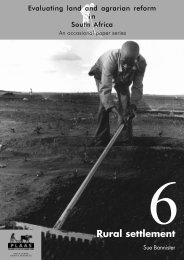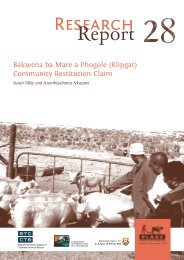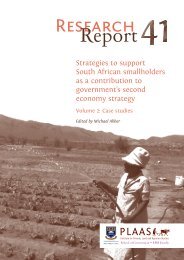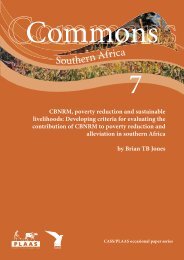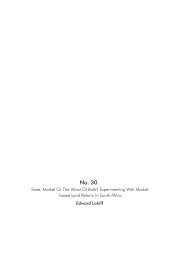A critical appraisal of South Africa's market-based land reform policy
A critical appraisal of South Africa's market-based land reform policy
A critical appraisal of South Africa's market-based land reform policy
You also want an ePaper? Increase the reach of your titles
YUMPU automatically turns print PDFs into web optimized ePapers that Google loves.
Chapter 7: Conclusions<br />
This study set out to <strong>critical</strong>ly examine the implementation <strong>of</strong> LRAD in<br />
Limpopo as an example <strong>of</strong> a <strong>market</strong>-<strong>based</strong> <strong>land</strong> redistribution programme.<br />
The major finding that emerges from the study is that LRAD, as it has<br />
been implemented in Limpopo, is neither a redistribution programme nor<br />
is it <strong>market</strong>-<strong>based</strong>.<br />
Of all the <strong>land</strong> acquired in terms <strong>of</strong><br />
approved LRAD projects handled<br />
by DLA in the province, 95.5%<br />
was already occupied and used by the<br />
intended beneficiaries and 82% was state<br />
<strong>land</strong> bought by the apartheid regime for<br />
incorporation into former home<strong>land</strong>s as<br />
part <strong>of</strong> the scheme <strong>of</strong> grand apartheid. The<br />
implementation <strong>of</strong> these LRAD projects on<br />
state <strong>land</strong> has merely completed a project<br />
initiated by the apartheid regime some 20<br />
years ago. The transfer <strong>of</strong> these farms in<br />
ownership to those who were already<br />
leasing them has done nothing to change<br />
the racial inequalities or structure <strong>of</strong> the<br />
agricultural sector in the country.<br />
Out <strong>of</strong> the 20 projects approved, only<br />
two actually involve the redistribution <strong>of</strong><br />
‘white commercial farm<strong>land</strong>’ as envisaged<br />
by the LRAD programme (DLA 2001).<br />
These two are the Mankweng Integrated<br />
project and the Vele Farm project. As<br />
Mankweng Integrated had not yet been<br />
implemented at the time <strong>of</strong> the research<br />
(April 2003), this meant only one beneficiary<br />
out <strong>of</strong> 251 had actually acquired<br />
ownership <strong>of</strong> <strong>land</strong> in a previously ‘white’<br />
area.<br />
One <strong>of</strong> the key targets for LRAD is to<br />
contribute to the redistribution <strong>of</strong> 30% <strong>of</strong><br />
agricultural <strong>land</strong> over a period <strong>of</strong> 15 years.<br />
The LRAD programme in Limpopo in its<br />
first years <strong>of</strong> implementation up to March<br />
2003 had approved the acquisition <strong>of</strong><br />
22 292ha <strong>of</strong> <strong>land</strong>, counting both the DLA<br />
and Land Bank projects. This is equivalent<br />
to just 0.9% <strong>of</strong> the agricultural <strong>land</strong> in the<br />
formerly white areas <strong>of</strong> the province.<br />
This is being generous to the programme,<br />
however, as many <strong>of</strong> the projects had not<br />
reached the point <strong>of</strong> <strong>land</strong> transfer and, as<br />
noted above, almost all the <strong>land</strong> to be<br />
acquired through LRAD was not actually<br />
in white ownership but had already been<br />
allocated for black use by the apartheid<br />
government and was already being used<br />
by black farmers. Clearly the programme<br />
is falling dramatically short <strong>of</strong> its own<br />
targets and making a negligible impact on<br />
the unequal and highly concentrated<br />
patterns <strong>of</strong> <strong>land</strong> ownership.<br />
It is important to consider whether<br />
LRAD represents any improvement over<br />
the SLAG programme it replaced. While<br />
the procedures for the approval <strong>of</strong> LRAD<br />
projects have been streamlined to some<br />
extent, the programme continues to rely on<br />
the willingness <strong>of</strong> sellers and a narrow<br />
‘demand-led’ approach. There is no increase<br />
in the amount <strong>of</strong> <strong>land</strong> provided<br />
through LRAD (22 292ha in three years)<br />
over that redistributed through the SLAG<br />
approach (45 110ha in six years). The<br />
SLAG projects, despite all their drawbacks,<br />
did acquire <strong>land</strong> in formerly white areas.<br />
SLAG also involved far more beneficiaries:<br />
6 753 households against the 376 individual<br />
beneficiaries <strong>of</strong> DLA and Land Bank<br />
LRAD projects combined.<br />
Surprisingly, while LRAD sets new<br />
targets for the amount <strong>of</strong> <strong>land</strong> to be<br />
redistributed, the budget allocations for its<br />
implementation have been reduced and are<br />
a fraction <strong>of</strong> what is needed to meet the<br />
stated targets (Tilley 2002).<br />
41







